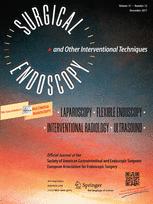Testoni PA, Testoni S, Mazzoleni G, Vailati C, Passaretti S
Surg Endosc. 2015 Sep;29(9):2770-80.
BACKGROUND:
Transoral incisionless fundoplication (TIF) with the EsophyX™ device creates an antireflux valve with good functional results inpatients with gastro-esophageal reflux disease (GERD). The aim of this study was to assess the long-term effect of TIF 2.0 on pathological reflux and symptoms in GERD patients with daily dependence on proton pump inhibitors (PPI).
METHODS:
Fifty patients underwent TIF. All underwent GERD-HRQL and GERD-QUAL questionnaires, upper GI endoscopy, esophageal manometry, and 24-h pH-impedance before and 6, 12, and 24 months after TIF, and subsequent yearly clinical re-evaluation.
RESULTS:
Patients were followed for up to six years (mean 52.7 ± 19.7 months). In all, 83.7, 79.6, 87.8, and 84.4 % of patients stopped or halved the PPI therapy 6, 12, 24, and 36 months after TIF. Three-year figure remained stable up to 6 years. Symptom scores off PPI were significantly lower at 6, 12, 24, and 36 months. At 6 months, Hill’s grade I of the newly created valve persisted in all pre-procedure Hill’s grade I patients, in 66.7 % of grade II and 58.3 % of grade III. This figure remained substantially unchanged at 12 and 24 months, too. Impedance monitoring indicated significantly fewer total and acid refluxes after treatment (p = 0.01). Factors predicting good outcomes were pre-procedure Hill’s grade I-II, no hiatal hernia or hernia ≤2 cm (p = 0.03), absence of ineffective esophageal motility (p < 0.0001), and number of fasteners deployed (p = 0.01).
CONCLUSIONS:
TIF by the EsophyX achieved lasting elimination of daily dependence on PPI in 75-80 % of patients for up to 6 years. TIF seems an effective therapy for selected symptomatic GERD patients.
Link to abstract on PubMed: Testoni PA, et al; Surg Endosc. 2015 Sep;29(9):2770-80.


